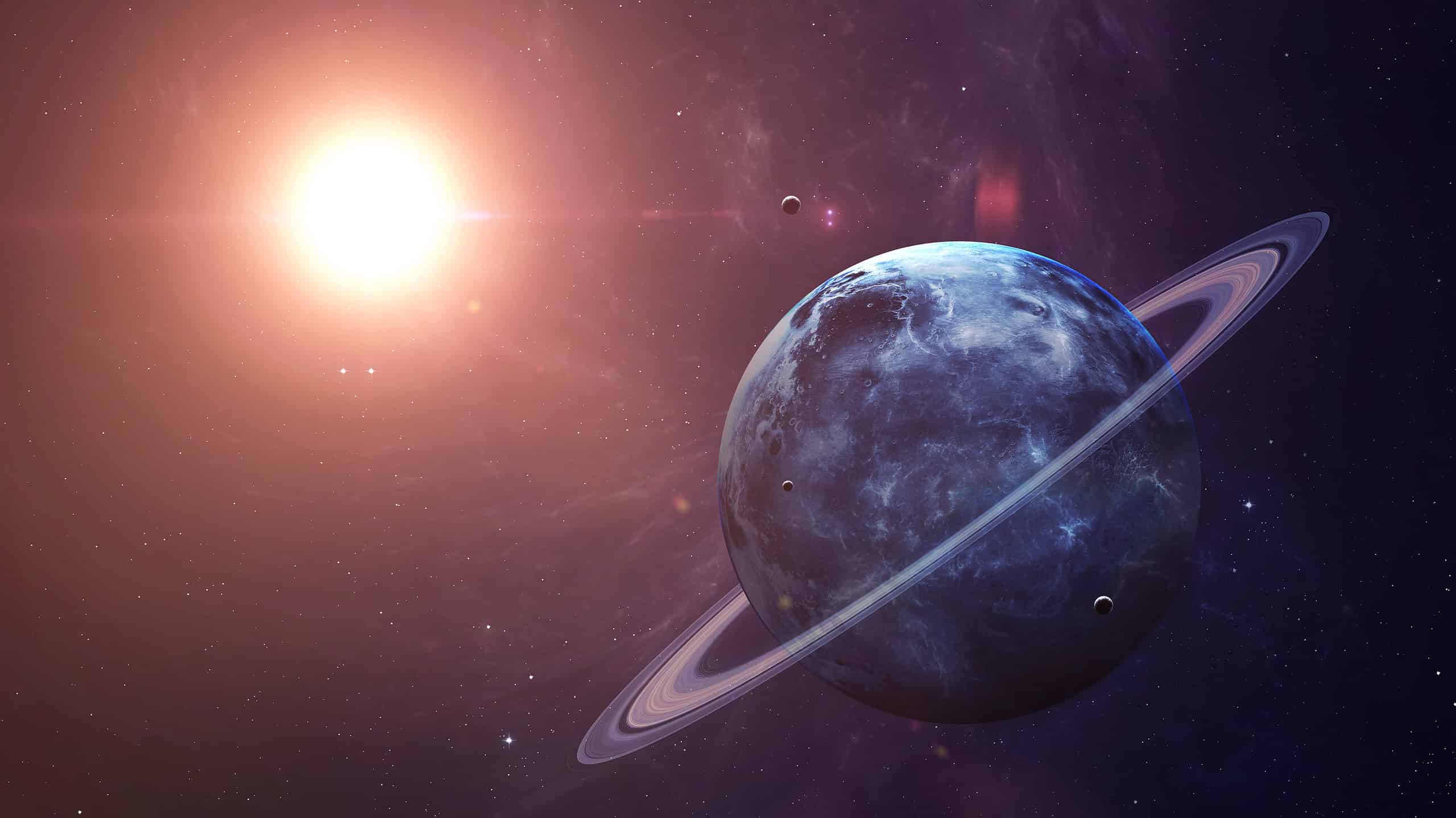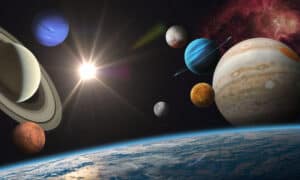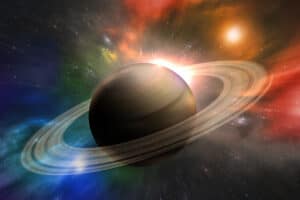If you look into your telescope late at night, you have a chance to see many of the countless stars and amazing planets that make up the cosmos. One of the plants you may see is Uranus. When many people see this planet, they are perplexed about the true color of the planet, and we’re here to answer that question. We’ll tell you the color of Uranus, the scientific principles that are at play to provide its unique hue, and other interesting facts.
What is the Color of Uranus?
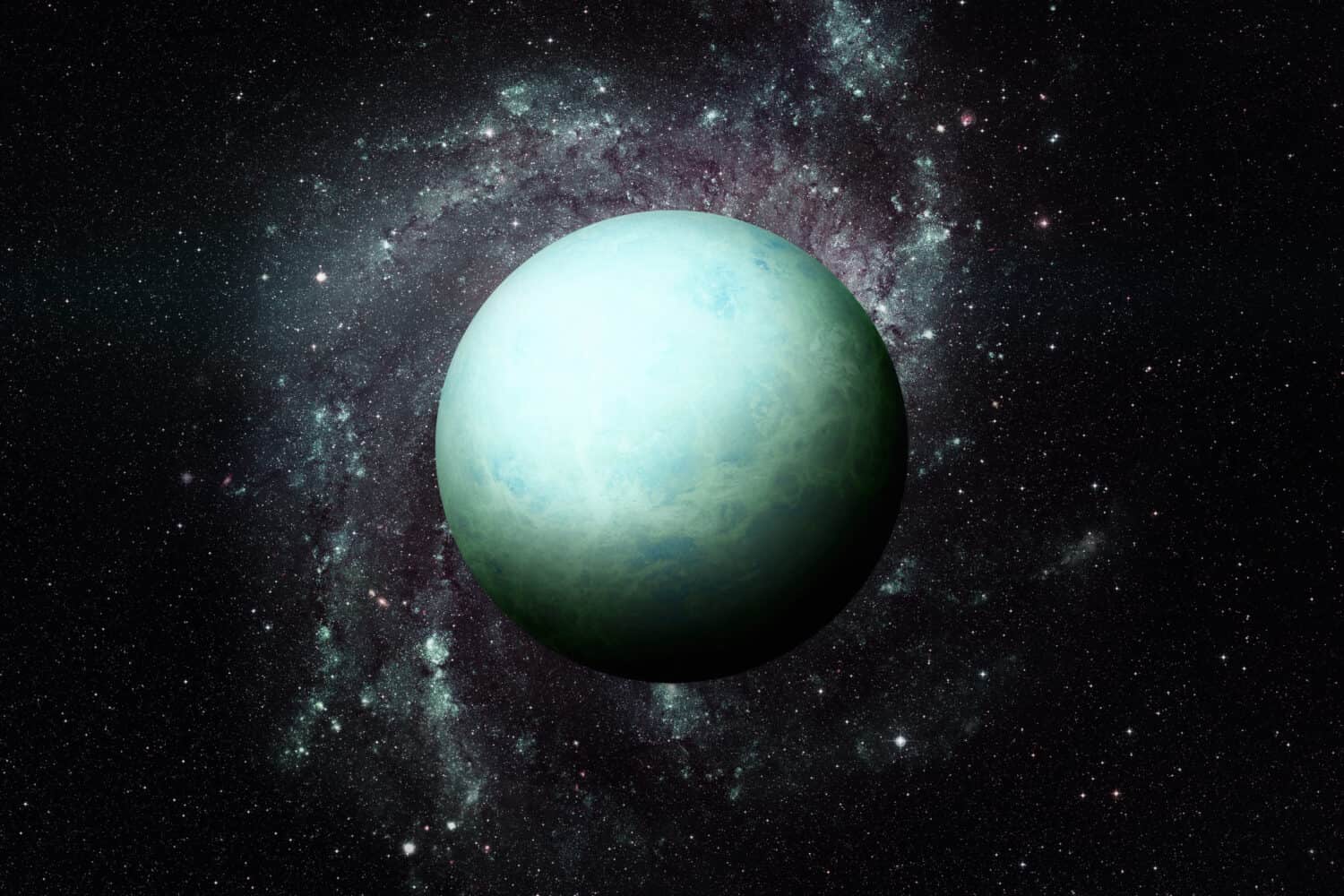
Unranus has a blue-green hue due to the elements in the environment.
©NASA images/Shutterstock.com
According to the space experts at NASA, the color of Uranus is a blue-green color.
Granted, the actual color of the surface may vary, but when we look up at it from Earth, it has this calming color. The reason for the blue-green hue is that there’s methane gas in the atmosphere. When sunlight passes through the atmosphere, it is reflected by the cloud tops over Uranus. The methane gas absorbs the red portion of that light, and we get that blue-green shade.
Some people believe that the color of Uranus is white because that’s what they see through their telescope. But again, that’s often the result of the methane absorbing the light. In essence, the cold methane gas is what provides that blue-green color.
Facts About Uranus
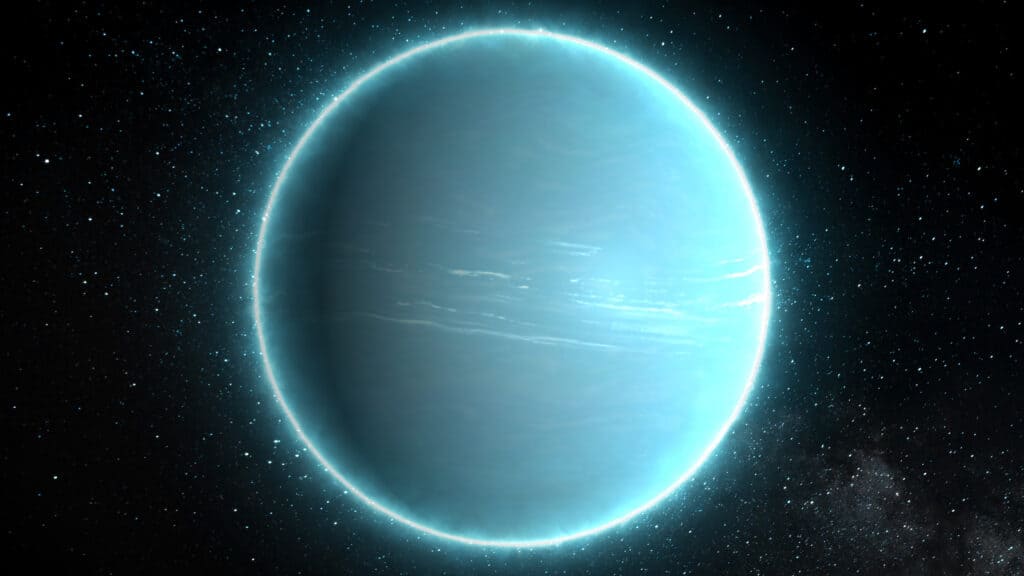
Uranus is mostly a collection of swirling fluids and gases.
©iStock.com/IncrediVFX
In addition to the unique color of Uranus, there’s a lot more to learn about this amazing planet. Here are the details that you need to know about the seventh planet from the sun.
The Name
The name Uranus is based on the Greek God of the sky, named Uranus. Originally, when William Hershel discovered the planet, he wanted to call it “Georgium Sidus” or “George’s Star” in honor of King George III, but the idea was turned down. Uranus was the first planet that was discovered with the use of a telescope, and it was first recorded in 1690. With that said, it is possible to see it with the naked eye if you look in the right spot and the night sky is completely dark.
Size of Uranus
There is a misconception among many that Uranus is a smaller planet. However, it actually has a radius of 15,759.2 miles, which is four times wider than Earth.
Distance From Earth
Uranus is approximately 1.8 billion miles from planet Earth or 19.8 astronomical units away from the Sun. For reference, an astronomical unit is measured as the distance from the Earth to the Sun, so you can imagine how far away this planet really is. To put that in perspective, it would take sunlight two hours and 40 minutes to travel from the Sun to Uranus.
Rotation and Orbit
A day on Uranus will take 17 hours because that’s the time it takes for the planet to make a complete rotation. The planet takes 84 Earth years or 30,687 Earth days to rotate around the Sun. That means one year for them is equal to 84 of ours.
Uranus is unique because it is the only planet in the solar system that has an equator that’s at a right angle to its orbit. The tilt of 97.77 degrees is likely due to the planet colliding with an Earth-sized object in the past. This tilt is the reason why the Sun only shines on the poles of the planet for a quarter of the year, and the rest of the time, the planet is a 21-year dark winter. Other than Venus, Uranus is the only other planet that rotates in the opposite direction (east to west) of the other planets.
Time is so radically different on Uranus that it would make you long for home. If you could stand on the surface of Uranus, you’d see the Sun rise and then it would stay up for 42 years.
Rings
Planet Uranus does have two sets of rings. There’s an inner set of nine rings that are narrow, dark, and gray. Then there are two outer rings. One of them is a reddish color, and the other outer ring is blue. The rings add more to the color of Uranus. The rings all have names:
- Zeta
- 6
- 5
- 4
- Alpha
- Beta
- Eta
- Gamma
- Delta
- Lambda
- Epsilon
- Nu
- Mu
Moons
At this point, Uranus also has 27 moons, but scientists are still investigating, so there may be more. The inner moons of Uranus are mostly half rock and half ice. However, the moon Mariel is primarily ice, along with a bit of carbon dioxide and ammonia.
Scientists believe that the outer moons are really asteroids that were caught in the planet’s orbit.
The moons all have names based on Greek or Roman mythology, and they are:
- Ariel
- Belinda
- Bianca
- Caliban
- Cordelia
- Cressida
- Cupid
- Desdemona
- Ferdinand
- Francisco
- Juliet
- Mab
- Margaret
- Miranda
- Oberon
- Ophilia
- Perdita
- Portia
- Prospero
- Puck
- Rosalind
- Setebos
- Stephano
- Sycorax
- Titania
- Trinculo
- Umbriel
In order of size, the largest moons around Uranus are Miranda, Ariel, Umbriel, and then Titania. The moons aren’t large. They range from 472 km and 1578 km in diameter. Most of the moons are dark, with the darkest being Umbriel. The lightest of the moons is Ariel.
Can We Live On Uranus?
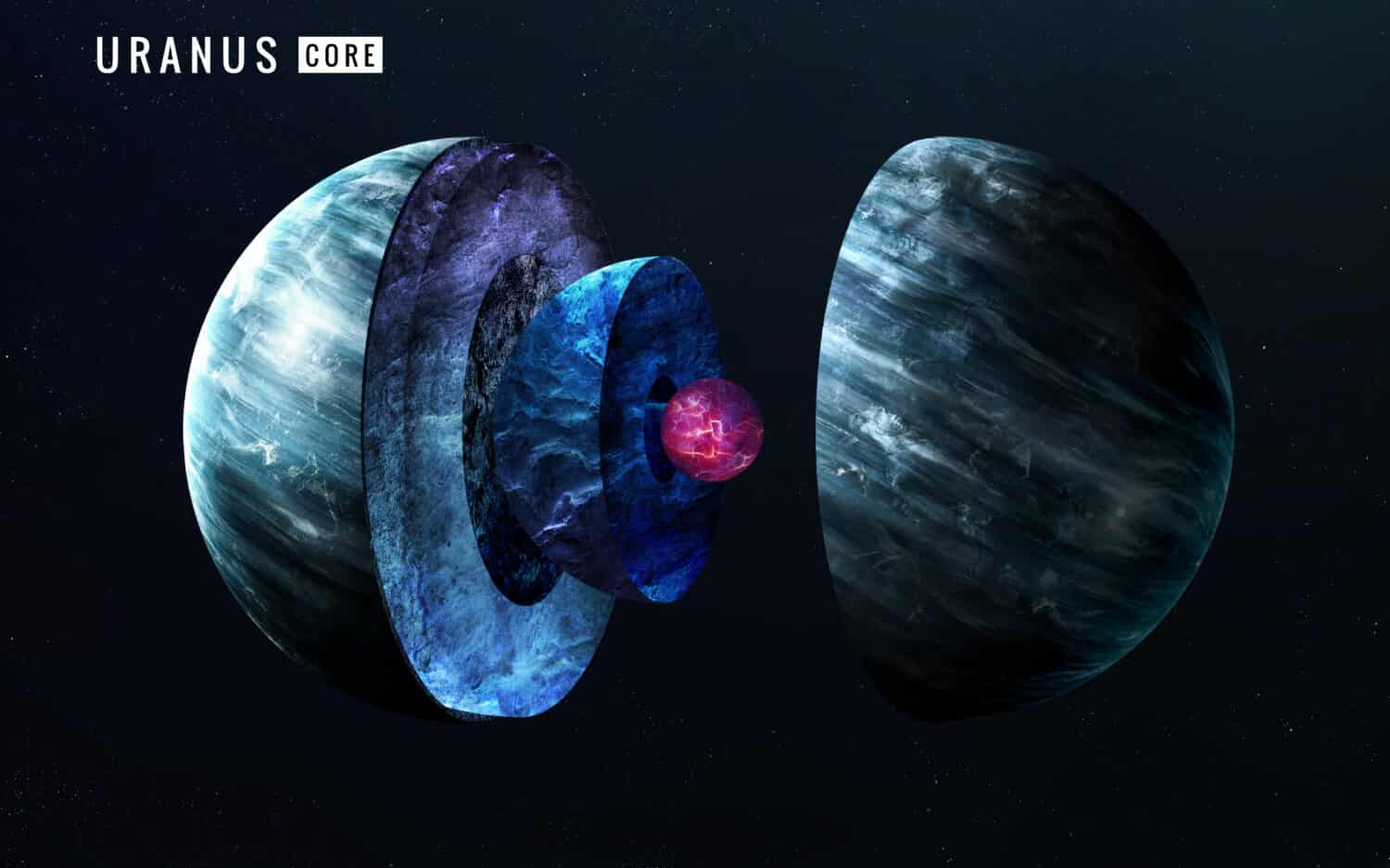
Uranus is uninhabitable because there is no solid ground on which to stand.
©Vadim Sadovski/Shutterstock.com
Although the color of Uranus may be alluring to some, the fact is that life on this planet would be impossible. The impossibility is due to the surface materials, temperatures, and the makeup of the atmosphere.
How Uranus was Formed
According to NASA, Uranus was formed close to 4.5 billion years ago. It became a planet due to the power of gravity pulling in swirling gas and dust that gives it the shape that we see today. Interestingly, when Uranus formed, it was actually closer to the Sun. However, four billion years ago, it started to shift to where it is now the seventh planet from the Sun.
Surface of Uranus
There are two main reasons why humans cannot live on Uranus, and one of them is that there isn’t an actual physical surface on Uranus like there is on Earth. The planet is just a bunch of swirling fluids, primarily helium, methane, and hydrogen. It’s a combination that would make breathing on the planet impossible.
Plus, because there’s no solid ground, people wouldn’t be able to walk on the planet, and spaceships wouldn’t be able to land there either. Even if we could land somewhere, the extreme temperatures and pressures would cause us great bodily harm.
Atmosphere of Uranus
That leads us to the other reason why humans wouldn’t be able to live on Uranus, and that’s the extremely cold temperatures. On average, the temperature at any given time is freezing minus 331 degrees Fahrenheit. Technically, Uranus has the record for the coldest temperature of anywhere in the entire solar system. Temperatures that cold would result in instant death.
Part of the reason for the cold is that the light from the Sun doesn’t rest on most of the planet. While the poles of the planet would see some sunlight, the rest of the planet is plunged into deep darkness.
The temperatures on Uranus are so cold because the planet is considered to be an “ice giant.” Even the clouds on the planet, which are composed of methane ice and ammonia, are cold, often reaching temperatures of minus 315 degrees F.
Oddly enough, the center of Uranus does have a rocky core, but we also could not live there either. That’s because instead of being bitter cold, it’s extremely hot, often reaching temperatures of over 9,000 degrees Fahrenheit.
Conclusion
Now you know the color of Uranus, along with many other amazing facts about this cold and distant planet. Next time you’re looking through your telescope, look for this blue-green planet and mark it off on your planetary bucket list.
Thank you for reading! Have some feedback for us? Contact the AZ Animals editorial team.

